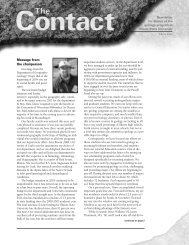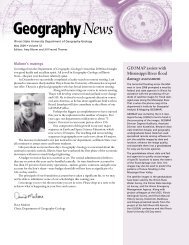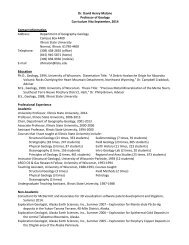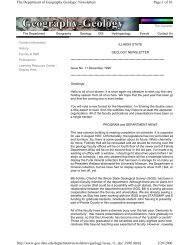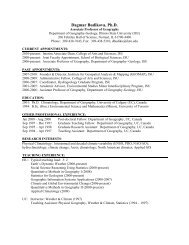Glacial Deposits.indd - Department of Geography - Geology - Illinois ...
Glacial Deposits.indd - Department of Geography - Geology - Illinois ...
Glacial Deposits.indd - Department of Geography - Geology - Illinois ...
You also want an ePaper? Increase the reach of your titles
YUMPU automatically turns print PDFs into web optimized ePapers that Google loves.
BUILDING AN ARCHIVE WITH SPECIAL REFERENCE<br />
TO THE LETTERS OF GEOGRAPHERS<br />
3<br />
By Ge<strong>of</strong>frey J. Martin<br />
F<br />
rom an earlier time, the writer wished to learn how American geographical institutions<br />
developed, what had been the mechanisms <strong>of</strong> growth, and at what point and under what<br />
circumstance had the whole evolved into a discipline poised on the threshold <strong>of</strong><br />
geographical science. Unfortunately, we did not have available a history <strong>of</strong> American<br />
geography. Your author wished to help change this state <strong>of</strong> affairs and decided to make a study<br />
<strong>of</strong> William Morris Davis, a most remarkable physical geographer. It was Davis who, in the<br />
1880s, conceptualized the origin <strong>of</strong> the discipline with his scheme <strong>of</strong> the cycle <strong>of</strong> erosion<br />
embracing the stages: youth, maturity, and old age. Under his tutelage there emerged a stream<br />
<strong>of</strong> what might be called human geographers. Davis, by the way, referred to human geography<br />
as ontography.<br />
So the plan constructed was to make studies <strong>of</strong> three <strong>of</strong> Davis’s finest students, Mark Jefferson,<br />
Ellsworth Huntington, and Isaiah Bowman. Jefferson specialized in the study <strong>of</strong> anthropography<br />
(the distribution <strong>of</strong> population); Huntington initially specialized in the effect <strong>of</strong> climate on human<br />
behavior (physiological climatology); and Bowman specialized on the individuality <strong>of</strong> regions<br />
(regional geography). These were the three fundamental designs for study deriving from the<br />
Davisian urging for some <strong>of</strong> his students to develop a human geography. This author published<br />
the resultant three books concerning the contributions <strong>of</strong> Jefferson, Huntington, and Bowman<br />
consecutively in 1968, 1973, and 1980.<br />
Each <strong>of</strong> these books was the product <strong>of</strong> reading publications <strong>of</strong> the particular author, and<br />
additionally their correspondence. In days now gone by, letter writing was a very important part<br />
<strong>of</strong> both academic and intellectual life. And usually it is in the correspondence that the life and<br />
thought <strong>of</strong> the scholar will stand revealed. There embryonic thoughts and feelings, frequently<br />
never to be published, may be shared with another, especially if the letter writers exchanged<br />
correspondence throughout a lifetime. Two <strong>of</strong> the best examples <strong>of</strong> this extended<br />
correspondence are Mark S. W. Jefferson-Isaiah Bowman, 1901-1949, and Richard E. Dodge-<br />
Albert P. Brigham, 1892-1932; each <strong>of</strong> these exchanges produced more than two hundred<br />
letters. And so one goes in quest <strong>of</strong> correspondence; such deposits may be found in a library, a<br />
geographical society, a nationally known repository, or a private holding. Warning: Be sure to<br />
correspond with the archivist in advance to learn <strong>of</strong> particular details, because in some<br />
instances it is required that the seeker have permission from next <strong>of</strong> kin. And in other instances,<br />
there might be a period <strong>of</strong> closure concerning the holding or part there<strong>of</strong>, which is quite<br />
frequently 25 or 50 years after a death.<br />
The quest for, and examination <strong>of</strong>, these holdings in far-flung deposits is an integral part <strong>of</strong> the<br />
undertaking. Accomplishment is hard won, and can otherwise be costly in time and money. Yet<br />
this is where the data reside. This pursuit is both footing and foundation <strong>of</strong> our field <strong>of</strong> learning.<br />
It is here where the untold history <strong>of</strong> our field resides. And study <strong>of</strong> the archives may have<br />
practical applications. For example, some archivists were employed in the Enigma Project <strong>of</strong><br />
World War II; others who have studied archival matters in geography have functioned as<br />
witnesses in a courtroom (e. g., Bowman in the Red River case) and yet others have parsed<br />
disputation <strong>of</strong> boundary squabbles by exploiting archival data, e. g., Lawrence Martin. And, as<br />
Archivist for the Association <strong>of</strong> American Geographers since 1986, I have received some 230<br />
inquiries concerning a variety <strong>of</strong> matters relating to the past, approximately 70 percent <strong>of</strong> which






